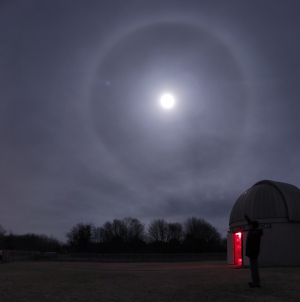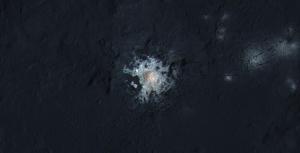
Stargazing Night
- Where:
- Frosty Drew Observatory
- When:
- Friday March 25, 2016 at 7:30 p.m.
- Cost:
- $1 Suggested Donation per Person
Tonight is Stargazing Night at Frosty Drew Observatory and forecasts are looking rather grim to start. We can expect mostly cloudy skies giving way to partly cloudy and clearer skies overnight. The 96% waning gibbous Moon will rise at 9:20 p.m. and will significantly brighten up the atmosphere, obscuring our view of dim celestial objects we would have been able to see if it wasn't cloudy. Though tonight, the bright Moon may offer us some redemption from the clouds, offering up views of the cratered lunar surface in between passing clouds.
We will open the Observatory and Sky Theatre at 7:30 tonight. In the Observatory, we will open on standby and closely monitor sky conditions for viewing opportunities. If clouds cut us a break, we will open our telescopes. In the Sky Theatre we will host an open discussion on general astronomy while featuring a showcase of celestial objects photographed at Frosty Drew Observatory. We'll stay on site and open until either 9:00 or midnight depending on what the clouds allow. Following Frosty Drew on Twitter (@FrostyDrewOBSY) or Facebook will get you updates on our status at the Observatory with a “Closing up” post when we decide to pack it in.
Overall, tonight's forecast coupled with a near full Moon will make for poor viewing conditions at Frosty Drew. If the Moon is your digs, or you just need an early spring astro-fix, then tonight will certainly present opportunities for you. Otherwise, the long drive may be better had on a more promising night. Regardless, if you're in the area and have a free night, stop in and geek out with our astronomers about all the awesome things happening in astronomy.
-------------------------------------------------------------------------
Weekly Happenings
Scott MacNeill
This past Tuesday, March 22, 2016, the NASA Dawn mission, which has been orbiting dwarf planet Ceres for the past year, released the most striking image, to date, of the mysterious bright spots in Occator Crater on the dwarf planet. Occator Crater is home to “Spot 5”, the brightest and most known of the bright spots on Ceres surface. These spots and the processes that are causing them pose a bit of a mystery to us. They are extremely bright, reflecting nearly all sunlight, and they maintain their brightness, which is unexpected on a world like Ceres. This is evidence of potentially recent geological activity. The recent image reveals a dome in the center of Spot 5 with numerous fractures across the dome. Though the mystery continues, a growing hypothesis of a salty subsurface ocean that may have broke through to the surface in the crater, leaving behind salt deposits, is gaining attention. Regardless, this is yet another fabulous example of how this amazing spacecraft is dramatically changing our view of the little world. Catch up on many of the geek-hot photos Dawn has been sending back to Earth.
Have you noticed that the date of Easter changes quite dramatically every year? Like Thanksgiving, Easter has a floating date, though over a much larger period of time. This happens because the date of Easter is determined by astronomical events. At first glace the date of Easter seems difficult to predict without a calendar, though it is actually quite easy and is as follows. Easter will fall on the first Sunday after the first Full Moon after the Vernal Equinox. If the first Full Moon after the Vernal Equinox happens to fall on a Sunday, then Easter will occur on the following Sunday (which happened in 2001). Since the 2016 Vernal Equinox occurred at 12:30 a.m. on March 20th, and the Moon reached its full phase at 8:01 a.m. on March 23rd (this past Wednesday), that marks this coming Sunday (March 27th) as the date of Easter 2016. So get out, hunt for eggs, eat candy, and celebrate the arrival of Spring with tasty treats shaped like bunnies and little chicks. Happy Easter!
-Scott


